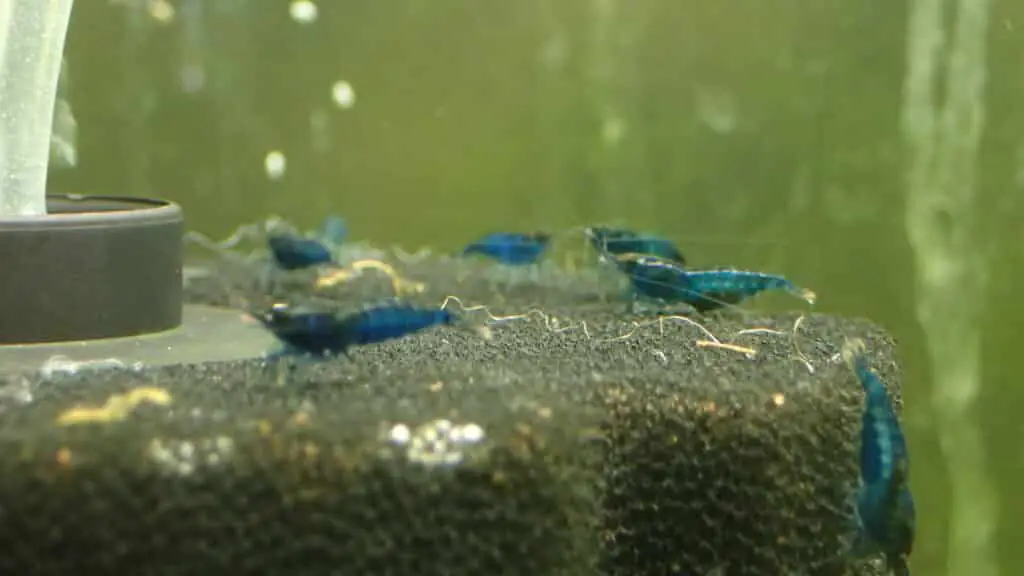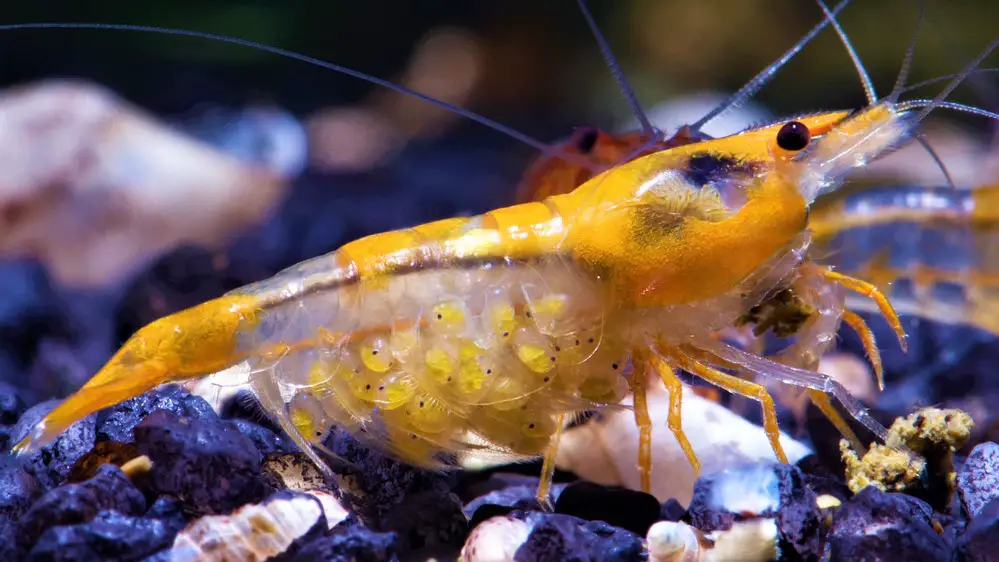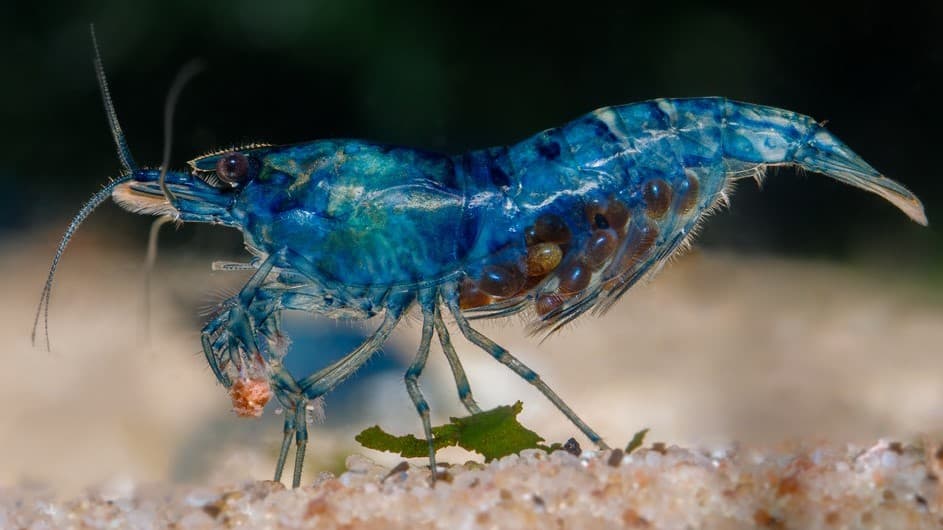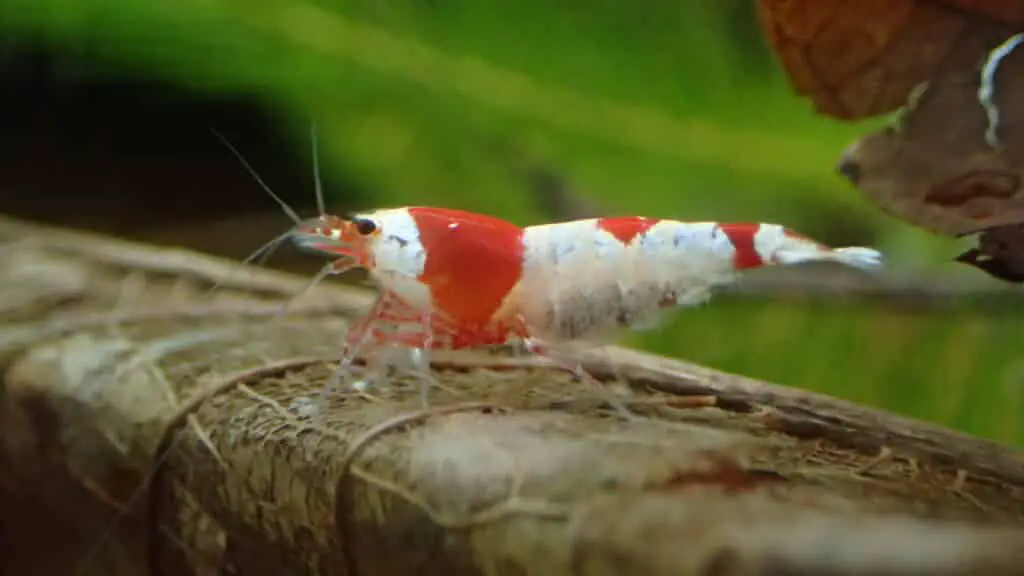Shrimp eggs are fertilized when they move from the shrimp’s back (the saddle) to the belly. This process involves the eggs passing through a tube where they get fertilized by the received sperm. Therefore, if you see eggs in the shrimp’s belly, they are definitely fertilized.
One of the most intriguing aspects of shrimp keeping is their reproductive process. I remember the first time I noticed a female shrimp, her belly full of yellow eggs. I was filled with anticipation and curiosity. Were the eggs fertilized? How could I tell? Over the years, I’ve learned to identify the signs of fertilization and the stages of shrimp reproduction. In this article, I’ll share my knowledge and experiences, providing a comprehensive guide on determining if shrimp eggs are fertilized.
The Process of Shrimp Fertilization
Shrimp fertilisation is a fascinating process that begins with the female shrimp developing eggs in a region on her back known as the “saddle” due to its saddle-like shape. These eggs are initially unfertilised and carry a distinctive colour, often appearing as a yellow or greenish hue.
When the female shrimp is ready to reproduce, she undergoes a process known as molting, where she sheds her exoskeleton. This molting process triggers the release of pheromones into the water, which signal to male shrimp that the female is ready to mate.
Upon detecting these pheromones, male shrimp in the vicinity will begin a frenzied search for the female. The first male to find her will mount her, and the mating process will commence. During this process, the male deposits sperm into the female’s body, which she stores for later use.
Following mating, the female shrimp moves the unfertilised eggs from the saddle to her belly. As the eggs pass through a special tube, they come into contact with the stored sperm, resulting in fertilisation.
Once the eggs reach the female’s belly, they are already fertilised. The female shrimp carries these fertilised eggs in her belly until they hatch, constantly fanning them with her pleopods (swimming legs) to provide them with oxygen.
The process of shrimp fertilisation is a delicate and intricate dance, influenced by various factors such as the shrimp’s environment, their health, and the availability of suitable mates. Understanding this process can provide valuable insights for shrimp keepers, helping them to create optimal conditions for shrimp reproduction and to recognise the signs of successful fertilization.

Identifying Fertilised Shrimp Eggs
Recognising fertilised shrimp eggs is an essential skill for any shrimp keeper. It allows you to monitor the reproductive health of your shrimp and anticipate the arrival of new shrimp babies, known as shrimplets.
Fertilised shrimp eggs are typically carried under the female’s belly, held in place by her swimmerets or pleopods. These eggs often appear as small, round or oval shapes, and their color can vary depending on the species of shrimp. For instance, Red Cherry Shrimp eggs often have a yellowish hue, while Ghost Shrimp eggs may be more greenish.
One of the most reliable ways to identify fertilised shrimp eggs is by their location. If you see eggs in the female shrimp’s belly, they are almost certainly fertilised. This is because the eggs are fertilised as they pass from the saddle to the belly, a process that occurs internally within the female shrimp.
Another clue is the behaviour of the female shrimp. Females carrying fertilised eggs, often referred to as “berried” females due to the berry-like appearance of the egg cluster, will regularly fan the eggs with their pleopods. This behaviour helps to oxygenate the eggs and is a good sign that the eggs are fertilised and developing.
the eggs with their pleopods. This behaviour helps to oxygenate the eggs and is a good sign that the eggs are fertilised and developing.
In some cases, you may be able to see tiny eye spots on the eggs, indicating that the shrimplets are nearing the end of their development. However, this requires a keen eye and may not be visible in all shrimp species.
Identifying fertilised shrimp eggs can be a rewarding part of shrimp keeping, signalling the promise of new life and the continuation of your shrimp colony. It’s a testament to the successful care and environment you’ve provided for your shrimp.

The Role of the Saddle in Shrimp Reproduction
The “saddle” plays a crucial role in shrimp reproduction. Named for its resemblance to a horse’s saddle, this structure is actually a region in the female shrimp’s body where eggs are developed and stored before fertilisation.
Located on the shrimp’s back, just behind the head, the saddle is often visible through the shrimp’s translucent body. The eggs within the saddle are initially unfertilised and can be seen as small, round dots. Depending on the shrimp species, these eggs may appear yellow, green, or another color.
The saddle’s role in shrimp reproduction begins when the female shrimp starts to develop eggs. These eggs grow within the saddle until the female is ready to reproduce. At this point, she undergoes a process known as molting, where she sheds her exoskeleton. This molting process triggers the release of pheromones that signal to male shrimp that she is ready to mate.
After mating, the female moves the eggs from the saddle to her belly. As the eggs pass through a special tube, they come into contact with the stored sperm from the male, resulting in fertilisation.
The saddle is therefore a key part of the shrimp’s reproductive system, serving as the site for egg development and the starting point for the journey that the eggs take from fertilisation to hatching. Understanding the role of the saddle can help shrimp keepers monitor the reproductive health and activity of their shrimp, providing valuable insights into the life cycle of these fascinating creatures.

The Journey of Eggs from the Saddle to the Belly
The journey of eggs from the saddle to the belly in shrimp is a fascinating process that marks the transition from egg development to fertilisation and eventual hatching.
Once the female shrimp has mated and stored the male’s sperm, she triggers the movement of the eggs from the saddle to her belly. This process is often initiated after the female molts, a stage where she sheds her exoskeleton, signaling that she is ready for the eggs to be fertilised.
The eggs travel from the saddle through a special tube known as the oviduct. As they pass through this tube, they come into contact with the stored sperm, resulting in fertilisation. This journey is a one-way trip – once the eggs have moved to the belly, they do not return to the saddle.
Upon reaching the belly, the fertilised eggs are held in place by the female’s pleopods, or swimming legs. Here, they will remain until they are ready to hatch. During this period, the female shrimp takes on the role of a dedicated mother, constantly fanning the eggs to provide them with oxygen and protect them from potential threats.
This journey from the saddle to the belly is a critical phase in the shrimp’s reproductive cycle. It signifies the successful fertilisation of the eggs and the beginning of the next generation of shrimp. As a shrimp keeper, witnessing this journey can be an exciting and rewarding experience, offering a glimpse into the intricate and fascinating world of shrimp reproduction.

The Impact of Environmental Factors on Shrimp Fertilization
Environmental factors can significantly impact the fertilisation process in shrimp. As sensitive creatures, shrimp require specific conditions to successfully reproduce. These conditions include water temperature, water quality, diet, and stress levels.
Water Temperature: The temperature of the water in your shrimp tank can influence the rate at which shrimp mature and reproduce. Warmer temperatures can speed up the shrimp’s metabolism, leading to faster growth and more frequent molting. This can result in a quicker reproductive cycle. However, excessively high temperatures can also stress shrimp and potentially harm their health.
Water Quality: Shrimp require clean, well-oxygenated water for optimal health and reproduction. High levels of ammonia, nitrites, or nitrates can be harmful to shrimp and may inhibit their ability to reproduce. Regular water changes and a well-cycled aquarium are essential for maintaining good water quality.
Diet: A balanced diet is crucial for shrimp reproduction. Shrimp require a variety of nutrients for egg development and overall health. A diet lacking in essential nutrients can lead to poor egg development and reduced fertility.
Stress Levels: Stress can significantly impact shrimp reproduction. Stressful conditions, such as sudden changes in water parameters, aggressive tank mates, or inadequate hiding places, can inhibit shrimp from mating and carrying eggs to term. Ensuring a peaceful, well-structured environment is key to promoting successful shrimp reproduction.

Understanding the impact of these environmental factors can help shrimp keepers create optimal conditions for shrimp fertilisation. By carefully managing these factors, you can support your shrimp in their reproductive journey and enjoy the rewarding experience of seeing new shrimplets hatch in your aquarium.
What Happens After Shrimp Eggs are Fertilized
After shrimp eggs are fertilised, they embark on a journey of development that culminates in the hatching of new shrimplets. This process is a fascinating spectacle of nature that shrimp keepers can observe firsthand in their aquariums.
Once fertilised, the eggs are carried under the female shrimp’s belly, held securely by her pleopods or swimming legs. This stage is often referred to as the “berried” stage due to the berry-like appearance of the egg cluster.
During this period, the female shrimp takes on the role of a dedicated mother. She constantly fans the eggs with her pleopods, a behavior that helps to oxygenate the eggs and keep them clean. This fanning action is crucial for the development of the embryos within the eggs.
As the embryos develop, you may notice changes in the appearance of the eggs. They may darken in color, and in some cases, you might be able to see tiny eye spots. These are signs that the shrimplets are nearing the end of their development and are ready to hatch.
The hatching process usually occurs at night and can take several hours. Once hatched, the tiny shrimplets are fully independent and will start to explore their environment, feeding on biofilm and other microscopic food sources in the tank.
The period after fertilisation is a critical stage in the shrimp’s life cycle. As a shrimp keeper, providing a safe and healthy environment for the female shrimp and her developing eggs is key to ensuring the successful hatching of the next generation of shrimp.
Conclusion
The process of shrimp fertilisation, from the development of eggs in the saddle to their journey to the belly, and finally to the hatching of shrimplets, is a rewarding part of shrimp keeping. It allows us to appreciate the intricate life cycle of these fascinating creatures and to provide them with the optimal conditions they need to thrive and reproduce.
Remember, the key to successful shrimp breeding lies in maintaining a healthy environment, providing a balanced diet, and carefully monitoring the shrimp’s behavior and physical changes. Each stage of the process, from the appearance of the saddle to the fanning of the eggs, offers unique insights into the world of shrimp reproduction.
If you ever find yourself unsure or if you have any questions about shrimp fertilisation, don’t hesitate to reach out. There’s a whole community of shrimp keepers who are more than willing to share their experiences and knowledge. After all, we’re all in this journey together.
Happy Shrimp Keeping!
FAQ: Fertilized Shrimp Eggs
Q. What color are fertilized shrimp eggs? A. The color of fertilized shrimp eggs can vary depending on the species. For instance, Red Cherry Shrimp eggs often have a yellowish hue, while Ghost Shrimp eggs may be more greenish.
Q. What do fertilized shrimp eggs look like? A. Fertilised shrimp eggs appear as small, round or oval shapes, typically carried under the female’s belly. They are held in place by her pleopods or swimming legs.
Q. How do you know if ghost shrimp eggs are fertilized? A. Ghost shrimp eggs are fertilised if they are located in the female’s belly. They often appear greenish and are fanned by the female’s pleopods for oxygenation.
Q. Are my cherry shrimp eggs fertilized? A. If your Cherry Shrimp’s eggs are located in her belly, they are fertilised. Cherry Shrimp eggs often have a yellowish hue.
Q. What color are unfertilized eggs? A. Unfertilized shrimp eggs, located in the saddle, often appear yellow or green, but this can vary by species.
Q. What color are fertile eggs? A. Fertile shrimp eggs can vary in color by species but are typically yellowish or greenish.
Q. Are white eggs fertilized? A. In shrimp, white eggs are usually not a good sign and may indicate that the eggs are infertile or that the embryo has died.
Q. How do you know if a green egg is fertilized? A. If the green eggs are located in the female shrimp’s belly, they are likely fertilised. This is common in species like Ghost Shrimp.
Q. Can shrimp eggs hatch without mother? A. While it’s possible to hatch shrimp eggs without the mother, it’s a delicate process that requires specific conditions and careful handling.
Q. What if my shrimp has green eggs? A. If your shrimp has green eggs in her belly, they are likely fertilised. This is common in species like Ghost Shrimp. If the eggs are in the saddle and green, they are not yet fertilised.
